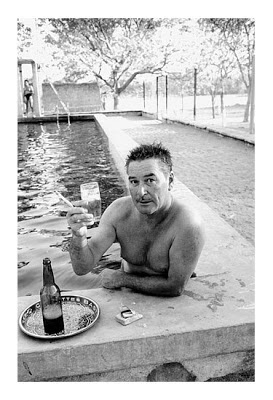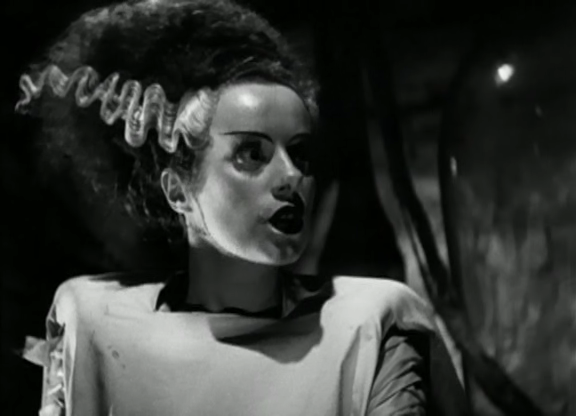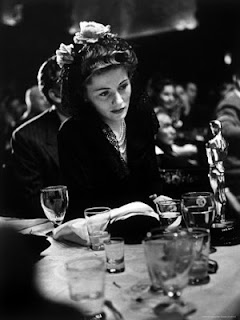 |
| Relaxing |
Nicknamed ' Baron '
by employer and nemesis Jack L. Warner, Errol Flynn swashbuckled his way through over 50 films. Starting in 1934 under contract to Warner Brothers Pictures at the age of 25, to his last, the exploitation film
Cuban Rebel Girls, at age 50,
Flynn cut a large path in Hollywood film history as the cinema's preeminent action-adventure star of his day before his death on October 14, 1959. His detractor's [ and there have been many ] say his best work was not on the screen but between the sheets, for Flynn was known far and wide for his wanton, wild ways. He made no secret of his love of women, drink and the occasional narcotic and his devil may care attitude toward hard work and his love of a good time sometimes spilled over into his work so that some critics, especially contemporary ones, had trouble separating the man from his myth. And some of the roles he took have a particularly autobiographical tinge to them. His Don Juan in 1949's
The Adventures of Don Juan is one of his best post WWII films and shows us a Flynn that understands the character he is portraying all too well.
 |
| Climbing to new heights as Don Juan, 1949 |
Flynn's Don Juan may be the most melancholy adventure hero in cinema history, for he plays Don Juan in a very world weary manner, a manner that entirely fits the situation Don Juan finds himself restricted to. Just returned to Spain after being kicked out of England, Juan finds himself a phallic symbol, as Flynn also did ever since his celebrated rape trial in 1942-43. It was a reputation Flynn could never escape. Juan also finds himself caught up in political intrigue between the King and Queen of Spain and the evil Duke de Lorca who has his sights on seizing the throne for himself. Furthermore, Juan finds he is strongly attracted to the Queen, but things being what they are and the Queen also not able to see Juan beyond his public reputation, nothing much comes of this relationship in a physical sense. Flynn married 3 times, but never found domestic life comforting for very long. He proposed to Ida Lupino in the late forties, while still unhappily married to wife #2 Nora Eddington. Lupino was reportedly a great pal of Flynn's and loved him dearly, but she turned him down [ probably a wise thing ]. However,
Adventures of Don Juan being an adventure for young adult males, there is a spectacular dual between Juan and de Lorca and their men. Juan beats de Lorca and saves the crown for the Queen but decides it is time to move on down the road in pursuit of more adventures, carnal or otherwise. Through it all, the women in this film are ready, willing and able to be alone with Juan and practically throw themselves at him simply because he is reputed to be a great lover. These are things Flynn repeatedly went through in his own life. In his portrait of Don Juan, Flynn plays this off as rather a bore and something that he
must do, whether he likes it or not. And though he rather enjoys his time with the ladies while in their company, it seems he would rather be elsewhere.
Adventures of Don Juan is pretty much Flynn's swan song to the type of film he toiled in since 1935 when
Captain Blood made him an instant star and made his film reputation, although there would be 2 or 3 more swashbuckler's in the next few years with scaled back production values, deflated budgets, and poor scripts,
Don Juan is Flynn's last classic in the genre.
 |
| With first wife " Tiger" Lil ",aka, Lily Damita |
 |
| With 3 of his 4 children Deidre, Rory and only son Sean in 1951 on set of Kim |
1957's
The Sun Also Rises finds a Flynn post-bankruptcy, on his third and last wife, playing a supporting part for the first time since stardom hit 22 years earlier and having to take fourth billing behind Tyrone Power, Ava Gardner and Mel Ferrer [ ! ]. Taking billing after the first two stars is understandable but Mel Ferrer? Never mind the billing, because our boy Errol walked off with the picture. Some said it was petty theft, but at this juncture in his sagging career Flynn needed a boost and
Sun was first class production all the way. In the previous 8 years since
Don Juan, Flynn in 1953 rode out his Warners contract of 18 years, making one mediocre picture after another. Flynn started but was unable to complete an independent CinemaScope production of
William Tell in Switzerland [ Flynn put up $430,000 of his own money but the Italian backers, backed out, leaving Flynn holding the bag ], his business manager died but not before embezzling thousands of dollars from Flynn, the IRS slapped him with a back taxes statement for a cool million and because of these financial setbacks ex- wife Lily claimed ownership of Errol's beloved home, Mulholland Farm, for his failure to pay back alimony. One body blow after another, it pretty much did Flynn in and he would take any job offered, for he was much in needed of cash. His last 6 films before
Sun had all been money losing ventures - foreign produced epics like
Crossed Swords and
Dark Avenger, Flynn's name still carrying some weight with the European movie going public. Others like 1956's
Istanbul were tired old rehashed plots with backlots standing in for the real locale. A couple of these films didn't even play America until much later or were on the second half of double bills. In other words, when Errol took fourth billing on
Sun he had nowhere to go but up.
 |
| As Mike Campbell in The Sun Also Rises, with Eddie Albert |
The Sun Also Rises, produced by former 20th Century-Fox production head Daryl F. Zanuck, is based on the celebrated novel by Ernest Hemingway about a handful of expatriates after WWI who, instead of returning home to the U.S., decide to stay on and work, play, drink and generally carouse their way through Europe. The plot isn't much, in fact the plot is pretty much what I described in my previous sentence. Flynn plays one Mike Campbell, once wealthy- now bankrupt - and down on his luck, but engaged to Lady Brett Ashley, played by Ava Gardner, the woman they all want to have. Tyrone Power is the lead, Jake Barnes. Mel Ferrer is Robert Cohn, friend of Jake's, who falls hard for Brett and causes all kinds of trouble during their time in Pamplona, Spain for the fiesta. The annual running of the bulls sequence is a highlight as are all the scenes in which Flynn appears but since he doesn't enter the picture until about the 40 minute mark the beginning can be especially trying. Once Jake and sidekick Bill Gorton, played by Green Acres' Eddie Albert, arrive in Spain, the pace picks up considerably with Eddie and Errol finding an immediate rapport as they both have a fondness for the bottle and are literally drunk for nearly the rest of the movie. This is what provides the most entertaining part of the film, the hijinks of these 2 drunks causing mayhem whenever we see them, though Flynn is also none too happy with Mel Ferrer's attention to his Brett and tries to pick fights with him every chance he gets.
 |
| Lobby card from the hotel room scene with Tyrone Power in The Sun Also Rises |
Flynn's best scene, the one that gives us a hint to his character's problem, is with Power's Jake Barnes [ see picture above ] after Lady Brett, who is rather the slut of all time, runs off with star bullfighter Pedro Romero [ an inept Robert Evans, years before his days as production chief of Paramount Pictures ]. Barnes goes to Mike in his room and asks Mike if he's going to be joining him and Bill for dinner and Mike reply's, with drink in hand, is sure he'll be there, but that it seems that there are about 12 people missing and laments his loss of Brett, and as Barnes leaves him on his own we see Mike setting his drink down and lowering his head into his hands. It's a touching scene and shows the real anguish Mike must be going through, despite appearances to the contrary. How many times did Flynn do this same kind of thing ? Drinking alone, wondering how his life may have been different and where he took the wrong road ? In his autobiography
My Wicked, Wicked Ways, published in December 1959 after his death, Flynn recounts sitting on the bed in his home, with gun in hand, seriously considering suicide but being unable to. When Flynn did these things isn't made clear in the book and maybe it doesn't have to, because the image of Errol Flynn--Robin Hood, Captain Blood, Sir Geoffrey Thorpe, Gentleman Jim Corbett, George Armstrong Custer, all whom he played in movies--considering suicide is quite startling.
 |
| Errol's favorite time of day, the cocktail hour |
No one in their right mind is saying
The Sun Also Rises is good cinema. Although the movie has much going for it including an outstanding musical score by Hugo Friedhofer, nice photography by Leo Tover, excellent location work and a not bad screenplay, the main level of criticism of the film is that the movie was miscast, that all the actors were a good 10 to 15 years too old for their parts. It's a legitimate complaint and I would have to agree with it, if this movie was made in say 1945 or 1946 the casting would've been spot on. But by 1957 the cast was way too old. Especially Flynn, who made a nice little comeback and got the best reviews of his career with this movie, was too old and he looked it. 47 when
Sun was made, he looks a good 10 years older and Mike Campbell, indeed all these characters, should be in their late 20's or early 30's. The best one can say about the film is that it's a guilty pleasure.
 |
| With his last companion, the teenaged Beverly Aadland, at his 50th and last birthday, June 1959 |
In fact the last few films Flynn made were guilty pleasures and Errol was generally the best thing in them. Following
Sun in 1958 Errol got the chance to play one of his idols and a man whom he befriended, John Barrymore, in
Too Much, Too Soon. This slice of Hollywood biography based on the memoir of Diana Barrymore, John's eldest, is ripe with fiction whether it be the names of certain people who played not insignificant parts in Diana's life or title's of the movie's both Diana and John made or the studio's each worked for, all are fictionalized. The one thing the film gets right or at least seems
to have a sense of truth about, is the relationship between Diana and daddy dearest. Flynn's Barrymore is way past his prime, as Flynn was in real life. Alone in his decaying Beverly Hills palace, an estranged father, drink his only constant companion, in danger of losing his home, with no work in sight and living off past triumphs, Flynn's Barrymore must clearly have been a man he not only understood but empathised with. Flynn himself was a year away from death, living in the once fashionable but now run down Garden of Allah [ in fact it would be torn down in 1959 ], living with his underage mistress, Flynn was essentially a laughing stock in Hollywood despite his good showing in
Sun the year before, there being talk of a Supporting Actor Oscar nomination for his stellar work. But there was no nomination for him and when
Too Much, Too Soon [ love that title ] was released, Flynn again walked away with the acting honors and talk of award consideration, but in the end nothing, for people believed Flynn was playing himself, a burnt out, alcoholic, wash-out, and to a degree he was. But if Cary Grant is to be believed, that the hardest thing to do is play one's self, then Flynn did, indeed, achieve excellence.
 |
| The ultimate adventurer. Flynn as Captain Geoffrey Thorpe in The Sea Hawk. |
Errol Flynn passed away in Vancouver on October 14, 1959. Always short on funds in the last 6 or 7 years of his life, he was trying to sell his beloved schooner, the Zaca. At the home of Dr. Grant A. Gould, Errol Flynn died of a heart attack, after complaining of back pains, at the age of 50, though the autopsy revealed a great many other ailments such as liver and kidney disease and cancer of the mouth. The coroner concluded that it was amazing that Flynn reached the age of 50. In those 50 years Flynn had seen more, done more, loved more, hated more and lost more than most men or women do in two life times. I suppose that is fitting for a man who was both heroic and cowardly, wild and introspective, rich and poor, sullen and comic, once handsome and later aged before his time, who would not let an opportunity for a new experience go by without at least dipping his foot into the pool. It may be that Errol Flynn was a portrait of Dorian Gray come to life.
































